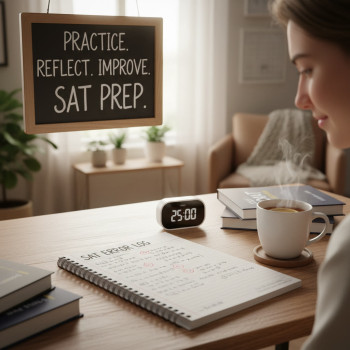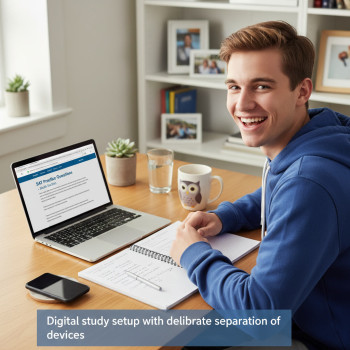AP vs SAT: Which One Matches Your Learning Style?
Deciding whether to lean into AP courses or focus on the Digital SAT can feel like choosing a musical instrument mid-recital: both ask you to perform, but each rewards different kinds of practice. For many students and families the question comes down to a simple but powerful idea: are you a reading-heavy, depth-driven learner, or do you thrive on quick, applied problem-solving? This post walks you through friendly, realistic comparisons, strategies to play to your strengths, and concrete next steps. I ll also show how a smart, tailored program like Sparkl s personalized tutoring can bridge gaps and amplify your strengths.
Why learning style matters more than you think
Tests and classes are designed around different thinking patterns. AP exams (and the college-level courses that prepare you for them) reward deep reading, sustained argumentation, and the ability to hold complex ideas across time. The Digital SAT rewards precision, speed, and the ability to translate knowledge into fast problem-solving under time pressure. Recognizing which pattern suits you not which one looks more impressive to colleges helps you study smarter, reduce burnout, and build a college application that reflects who you really are.
Understanding the two paths: AP courses vs the Digital SAT
AP: Reading-Heavy, Depth-Oriented
Advanced Placement classes replicate college-level learning in high school. Many AP subjects AP English Literature, AP U.S. History, AP Biology, AP Psychology ask students to read dense material, synthesize evidence, and express ideas in sustained writing or long-form responses. Success is often about preparation over time: reading widely, annotating carefully, and practicing thesis-driven essays.
Key qualities of AP-style work:
- Longer-form reading and writing.
- Emphasis on analysis, interpretation, and sustained argument.
- Project- and unit-based learning with cumulative assessments.
- Opportunities to demonstrate mastery through essays, labs, and extended responses.
Digital SAT: Problem-Solving, Time-Pressured
The Digital SAT is a modern, streamlined test built to evaluate evidence-based reading, grammar and language skills, and math problem-solving often under tighter timing than classroom assessments. While reading is still important, success leans on strategy: knowing how to parse questions quickly, eliminate wrong answers, and complete problems efficiently.
Key qualities of SAT-style work:
- Shorter passages and focused question sets emphasizing quick comprehension.
- Math questions that reward setup and logic over tedious calculation.
- Time management and test-taking strategy are crucial.
- Performance can improve rapidly with targeted practice and techniques.
Which one is right for you? Questions to ask yourself
Try answering these honestly these quick prompts cut to the heart of your natural tendencies.
- Do I enjoy reading long passages and digging into evidence, or do I prefer solving short puzzles and logic problems?
- Am I energized by class discussions and extended writing projects, or do I perform better in short, focused tasks?
- Do I get anxious when a clock is ticking, or does time pressure sharpen my focus?
- Do I want to show colleges deep subject mastery (AP) or a strong general aptitude across areas (SAT)?
Your answers won t be perfectly one-sided. Many students are hybrid learners who do well with both reading depth and problem-solving speed. That s good news: you can structure a plan that plays to your strengths while shoring up weaknesses.
How AP and Digital SAT compare at a glance
| Feature | AP Courses & Exams | Digital SAT |
|---|---|---|
| Primary Skill | In-depth reading, analysis, sustained writing | Quick comprehension, targeted problem solving |
| Format | Coursework + subject-specific exam (essays, free-response) | Computer-adaptive sections, multiple-choice and grid-in math |
| Preparation Time | Months through school year; cumulative | Can improve in weeks-months with focused practice |
| Best For | Students who love depth and want to demonstrate subject mastery | Students who think fast, manage time well, and want a general demonstration of college readiness |
| College Impact | Can earn college credit or placement; demonstrates rigorous curriculum | Common admissions benchmark; used across many colleges |

Real-world examples: How different learners approach both
The Deep Reader
Case: Maya, a junior who adores literature and history. She spends Sunday afternoons annotating novels and preparing for lively class debates. AP English Literature and AP U.S. History are natural fits; they let her show her critical thinking and earn college credit.
How she prepares:
- Schedules weekly long-read sessions to build stamina.
- Practices timed essays periodically to improve pacing for AP exam days.
- Uses feedback loops teacher comments, peer review to refine argument clarity.
The Fast Solver
Case: Jordan, a sophomore who thrives on logic puzzles and loves quick wins. He gets energized when he can see immediate progress, which makes targeted Digital SAT practice rewarding. Short, focused practice sessions yield big improvements in his scores.
How he prepares:
- Focuses on question-type drills and time management strategies.
- Mocks full-length Digital SATs under exam conditions to build endurance.
- Works on vocabulary and evidence-based reading in short bursts to sharpen comprehension.
Strategies that work for each learning style
For Reading-Heavy Learners (AP-Focused)
- Schedule longer reading blocks 45 to 90 minutes 3 4 times per week to build close-reading stamina.
- Practice note-taking styles (Cornell notes, margin annotations) so you can quickly retrieve evidence during essays.
- Write short, frequent practice responses to build clarity and speed for free-response questions.
- Form study groups to debate interpretations AP exams reward a nuanced understanding, not rote summaries.
- Balance breadth and depth: cover the whole course but master a few recurring themes that appear every year.
For Problem-Solving Learners (SAT-Focused)
- Adopt micro-practice sessions (25 45 minutes) with immediate review speed and accuracy compound quickly.
- Drill question types rather than topics. If you struggle with algebra word problems, practice dozens of those until patterns emerge.
- Use digital tools and practice tests to get comfortable with the Digital SAT interface.
- Develop scratch-paper strategies: quick diagrams, backsolving, plugging answer choices.
- Simulate test conditions and gradually shorten breaks and increase sustained focus windows.
Hybrid approaches: Combining the best of both
Most successful students blend both styles. You can take AP courses to demonstrate academic rigor while preparing for the Digital SAT as your common admissions benchmark. Here are practical hybrid strategies:
- Use AP readings as SAT reading practice annotate for evidence and then answer SAT-style questions on the same text.
- Turn AP problem sets (like AP Calculus practice) into timed drills to build both depth and speed.
- Schedule alternating study blocks two days deep reading, two days targeted SAT drills so both skills improve consistently.
Sample 12-Week Hybrid Plan
This example assumes you re preparing for both AP tests in the spring and the Digital SAT in the fall or winter. Adjust pacing to match your school calendar.
| Weeks | Focus | Weekly Routine |
|---|---|---|
| 1 4 | Foundation | 3 long reading blocks (60 90 min), 2 SAT drill sessions (30 45 min), 1 practice essay or AP free-response weekly |
| 5 8 | Intensify | 2 long readings, 3 SAT drills, 1 full-length practice test every 2 weeks, targeted review of weaknesses |
| 9 12 | Polish & Simulate | 1 long reading, 2 SAT drills, full-length practice test weekly, timed AP-style essays, exam logistics practice |
Where personalized tutoring fits and why it helps
One-size-fits-all study plans rarely produce peak results. Personalized tutoring addresses the exact moments you stall: whether that s interpreting a tricky passage or learning a math shortcut that shave minutes off your time. Sparkl s personalized tutoring model focuses on 1-on-1 guidance, tailored study plans, expert tutors, and AI-driven insights that find the most efficient path from where you are today to where you want to be. That can mean deep work on AP free-response technique one week, then a sprint of Digital SAT strategy the next.
Benefits of a tailored approach:
- Targeted feedback that turns recurring errors into learning opportunities.
- Flexible pacing so you don t waste time on material you ve already mastered.
- Confidence-building through measurable, short-term goals.
Common myths and gentle reality checks
- Myth: “AP scores are always better for college admissions than SAT scores.” Reality: Colleges view both in context. APs show subject rigor; SAT is a standardized comparison. They answer different questions.
- Myth: “If I m bad at timed tests I should avoid the SAT entirely.” Reality: Timed test skills are teachable. With strategy and practice you can reduce anxiety and improve speed dramatically.
- Myth: “APs require only memorization.” Reality: The best AP students analyze, synthesize, and argue skills that serve you in college and beyond.
How parents can support without taking over
Parents have a pivotal role encouraging routine, helping create a calm study space, and celebrating progress. Here are practical ways to help without micromanaging:
- Help build a balanced weekly schedule and protect study windows from interruptions.
- Ask reflective questions after practice tests: “What surprised you? What took the longest?”
- Encourage small rewards for milestones completing a full practice AP essay or shaving five minutes off a timed section.
- Consider a short trial of personalized tutoring if progress stalls sometimes an outside coach unlocks momentum quickly.
Measuring progress what to track
Trackable, simple metrics keep motivation high. Here are effective indicators:
- Practice test scores and score breakdowns by question type.
- Time spent per question or passage (especially for SAT practice).
- Frequency and types of errors are they conceptual mistakes or careless slips?
- AP-style rubric scores for essays and free responses look for improvements in thesis clarity and evidence use.
Putting it together: a decision checklist
Use this checklist to translate reflection into action:
- Do you prefer depth (AP) or breadth and speed (SAT)?
- Do your high school goals include college credit or advanced placement in certain subjects?
- How soon will you need an official score for applications?
- Do you have consistent time each week for long reading blocks?
- Would targeted tutoring that adapts to your learning style help you make faster progress?
Final thoughts: Play to your strengths, then expand them
There s no single “right” choice between AP and the Digital SAT only what matches your current strengths, goals, and energy. A reading-heavy student can learn the art of fast problem-solving; a rapid solver can benefit from deep analytical practice. The trick is to be intentional. If you re leaning toward AP, prioritize regular close-reading and timed essays. If the SAT feels like the smarter short-term investment, focus on targeted drills and full-length simulations. And if you want a smarter, faster way to improve, consider how personalized tutoring like Sparkl s 1-on-1 guidance, tailored study plans, expert tutors, and AI-driven insights can customize practice so every minute counts.
Whether you re annotating a dense passage at 9 p.m. or sprinting through a set of SAT math problems on a Saturday morning, remember: progress is built in small, steady steps. Choose the strategy that fits who you are today, and give yourself permission to grow into who you want to be tomorrow.

Next steps (quick action list)
- Take one short diagnostic: an AP-style free-response or a timed Digital SAT section to see what feels natural.
- Create a 4-week plan based on your result: focus on reading stamina or timed drills accordingly.
- Set one measurable goal for the next month (e.g., improve AP essay rubric score by one point or shave 10 minutes off a practice SAT section).
- If progress stalls, try a 1-on-1 tutoring session to get a customized plan and rapid feedback.
Whatever path you choose, keep curiosity at the center. Tests are snapshots, not definitions. With focused effort, the right strategies, and support that understands your learning style, you ll not only improve scores you ll build skills that last long after the exam day glow fades.
Good luck, and enjoy the learning process. You ve got this.















No Comments
Leave a comment Cancel